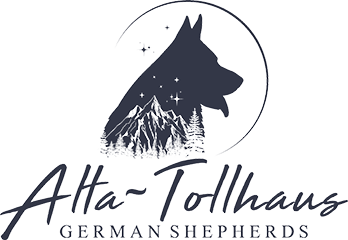Puppies and Raw Diets
by Anne Moore
Switching a puppy to a raw diet is so easy a caveman could do it – and did, actually. A raw diet is a dog’s natural diet, pre-dating commercial kibble by centuries. My philosophy is: nature knows best, and the further we stray from nature’s model, the worse we humans screw it up! Feed a puppy as you would an adult dog – lots of meat, a little edible bone, small amounts of organs. It is simply not true that puppies need “more” of anything than adult dogs.
So, here’s how I switched my Alta-Tollhaus girl to raw-feeding (and how I’ve switched several dozen others, including Pembroke Welsh Corgis and a number of fosters of various (sometimes indeterminate) breeds.
I always start a newbie-to-raw -– puppy or adult — with bone-in (aka split) chicken breasts. There is a good meat-to-bone ratio, and the bones are easy-peasy. I simply cut into the chicken meat, giving pup something to grab onto, and hand the piece to the puppy. Most puppies “get it” immediately: “Hey! This is food!” and work on the chicken diligently. I have seen a couple of puppies who needed a little extra help – a little bit of parmesan cheese rubbed into the slits in the meat usually does the trick.
Once pup is consuming the entire breast piece, bone and all, I quickly move on to other proteins. Puppies adapt quite easily to new meats, unlike some adult dogs, where sloooooowly adding small amounts of “new” is a much better plan.
Within two weeks of starting raw-feeding, my puppies will have eaten: chicken, turkey, pork, venison, elk if we have it, beef heart, rabbit, lamb/mutton, and probably fish.
Folks always want to know how much to feed their puppy. Those who are detail-oriented will be appalled to read that I don’t weigh or measure anything, ever. Not even for puppies! I just feed my dogs. But, that casual philosophy doesn’t work for everyone, so here’s a little guidance. Feed approximately 2-3% of the puppy’s anticipated *adult* weight! So, if your female should weigh around 55-60 lbs. as an adult, she will need about a pound of food per day. And yes, puppies *do* eat as much as an adult dog, but they should have several meals daily to consume it.
I feed puppies four times daily until the age of four months, three times until the age of six months, and twice daily until around a year of age. At that point, I move pup to once daily meals, as I like to be able to offer large, oddly shaped, more complicated meals. Eating is more than just nutrition when you’re raw-feeding – it also provides a physical work-out for jaws, neck, shoulders, and is mentally and physically challenging at its best.
If you are feeding two meals daily, you can choose to feed a small meal or snack in the morning, for example, and a larger, more challenging meal at night.
For working or sport dogs, the percentage above may not provide enough nutrition to maintain healthy weight. The percentage is a guideline only; feed more if your dog is too thin, and feed less if he’s getting pudgy.
Put your hands on your dog often. Run your hands down his ribcage; you should be able to easily feel his ribs. Being able to see a last rib or two is actually a good thing! Lean is better than fat for lots of reasons!
Here are some raw-feeding basics. . . dogs’ nutritional needs are simple: they need meat, small amounts of edible bone, small amounts of various organs. Despite what kibble manufacturers would have us believe, there is no need for a “balanced” meal each time we feed our dogs, nor even over a period of a week or month. Balance is “over time,” and there’s much less to getting it right than they insinuate. Frankly, it insults my intelligence that kibble companies infer that we aren’t smart enough to feed our own dogs!
Here’s a link to a short article I wrote for a Yahoo GSD group owned by a friend: http://www.leespets.com/feedraw.htm
I would be glad to answer any questions anyone may have on the subject of raw-feeding or switching puppies to a raw diet. It’s not complicated or difficult, and it is, IMO, the cornerstone of true good health in dogs!


Super article Ann! Thank you very much.
Ann is a long-time breeder of quality Pembroke Welsh Corgis. After talking to her about how she weans her puppies right to raw food, I switched over my remaining puppies to a raw diet. There was no need what so ever to rub cheese on the meat. 🙂 The pups devoured the food like they had never eaten before.
So the question I am getting from the the new owners of these pups is how to switch them back to kibble. This was Ann’s recommendation: Raw one meal, kibble the next. That’s sad, though; I guess I don’t ‘get’ knowing that raw-feeding is the best, most natural diet for a dog.
Is feeding a little raw and kibble together a bad idea?
Jon — Some folks will tell you that raw digests at a different rate than kibble, but that hasn’t been proven. What is “bad” about it, IMO, is the kibble; it’s full of non-human grade ingredients, grains and other fillers that take up space but don’t really provide good nutrition. I want to know exactly what my dogs eat, and if I buy human grade meat, I control that aspect. I don’t trust big corporations to want the best for my dogs, frankly, and since I managed a pet store for a while, I know what their motivation is — profit! With rawfeeding, I control quality, first and foremost, plus quantity/amounts, etc. — Anne
Thank you so much Anne!
When the pups are really teething I recommend frozen raw chicken and bone pieces to numb the gums and give them something to gnaw on. I would always say give it separate from the kibble meal, because that is what you hear, they digest at different rates. Most of the people I would tell this to would feed the raw and kibble together and they never had any problems. So the question I ask is, so what if they digest at different rates?
Thank you for the information Anne! Do you recommend giving any supplements/vitamins when only feeding raw? If so, are there any types/brands that you suggest?
Becky — if you’re feeding a variety of body parts from a variety of critters, *and* are feeding a good amount of red meat, supplementation is not a requirement. The only exception, IMO, is salmon oil or fish body oil (as opposed to cod liver oil), as Omega 3’s are lacking in much livestock (pasture-fed would have those O-3’s, but feedlot animals do not). That’s the only supplement that I regularly use.
I did not know that about Omega 3s. Good info Anne. I have had many comments off-line about how much people enjoyed your article on feeding raw. Thank you again for sharing your expertise with us.
That’s really nice to hear, Julie! Rawfeeding is one of the subjects I’m passionate about, and I think that it’s especially appropriate for GSDs, certainly a very “basic” breed, IMO (no frills, natural, etc.). Thanks for the compliments. You just may be sorry you got me started!! LOL